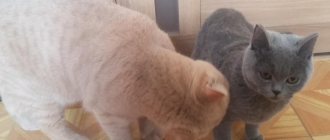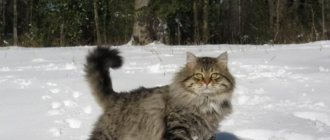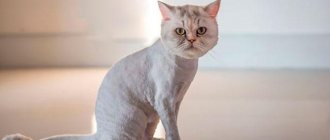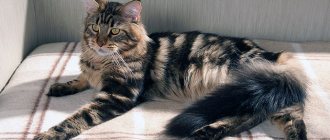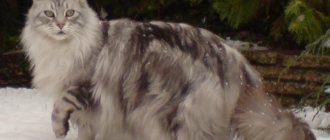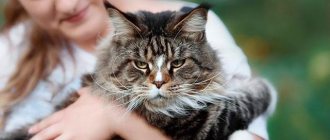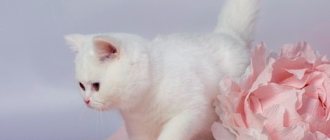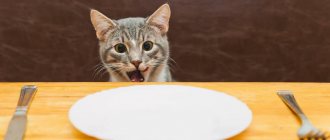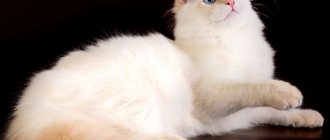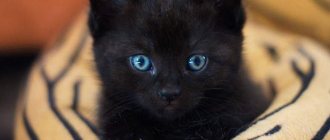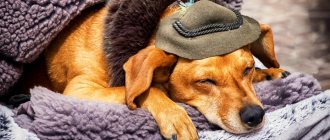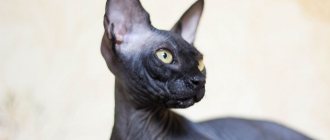Breed standard
The British cat is a compact, but quite powerful and well-balanced representative of the feline, which has a strong and wide body. Outwardly, he looks like a soft teddy bear, as nature has endowed him with a luxurious coat.
Advertising:
Like other popular breeds, the British cat has its own distinctive characteristics and standards, which are difficult to confuse with the features of a simple yard cat.
Weight and size
British cats are distinguished by their large and quite massive size, which cannot be said about female cats. They are noticeably smaller.
The weight of a British Shorthair cat varies from 6 to 9 kg, females - 4-6 kg.
Longhaired British cats differ slightly in their size. The average weight of a male cat is 6.5 kg, and that of a female cat is 4.5 kg.
Such differences are explained by a mutation that occurred during the crossing of the shorthaired breed with Persian and Somali cat species.
Head
The British head shape is oval, with wide cheekbones and slightly sagging cheeks. They are the ones who conquer the experts of this breed. The nose is wide, short and slightly flattened. The forehead is rounded. The chin is smooth and strong. The breed is also endowed with a wide and short neck.
It is on the parameters of the head that many standards have accumulated that attract the attention of experts.
Eyes
The eyes of British cats are very expressive. They are large, round and wide open. The color of the eyes often depends on the color of the coat and can be deep gold, blue or green.
The main color is considered to be gold or even rich orange. A British cat with this eye shade is shown in the photo:
Blue eyes are found in carriers of point and light colors. Green eye color is found in silver and golden shades of coat.
Body
The Briton has a large build, but short and powerful limbs. The body is squat. The back is short and straight. The shoulders are massive and wide. The tail is thick, medium-long and rounded at the tip.
Wool
The coat is also an important distinguishing feature of this breed. This soft and plush appearance is achieved due to the same length of hair with the undercoat. The coat is thick and short, but does not lie closely to the body.
Color
If we talk about the shade of the coat, then such breeds come in a variety of roles. There are about 60 colors in total. The main ones are:
- blue;
- faun;
- lilac;
- black;
- chocolate;
- cinnamon;
- cream;
- tabby (marbled, spotted) and others.
Appearance
According to CFA standards, the British chinchilla has smooth and rounded body shapes. The coat is thick with frequent undercoat. The color of short-haired dogs is bright and more pronounced in contrast to the long-haired variety.
There are three types of color:
- silver;
- silver-shaded.
- golden (also called the British golden cat).
Usually the name British chinchillas is applied to cats of a silver-shaded color. According to established standards, the tip of the tail should be colored black only by an eighth part.
Both of the first types on the list are classified as smoky varieties, but depending on the degree of hair coloration they are divided. Silver-shaded cats have darker fur due to the fact that the hairs are dyed black by a third. This is especially noticeable on the paws, tail and ears. In silvers these parts are white.
According to the description, this breed has bright emerald eyes, but green or yellow shades are found in shaded silver ones.
The golden chinchilla is also partially colored. The back, tail and sides are characterized by a blackish veil, and the belly and chest are apricot-colored.
A small photo gallery of chinchillas:
British shorthair cats
The British Shorthair cat is one of the ancient breeds, the pedigree of which stretches back to the times of Ancient Rome. At that time, such pets were valued for their dexterity and ability to catch rodents.
In the 19th century, many breeders showed interest in such an animal with a unique appearance, deciding to achieve recognition of a new breed - the British Shorthair.
Today, this friendly, decorative companion is an ideal pet with English manners. Due to the fact that this breed was highly valued in aristocratic families, it was not crossed with other species for a long period.
Breeders tried to maintain this plush appearance, improving only the color palette. But over time, after crossing, kittens with long hair began to appear, which were immediately identified as a “reject” of the breed and were not subject to further breeding.
Castration
There are several indications for sterilization and castration of chinchillas:
- predisposition to hereditary diseases;
- non-compliance with standards and exclusion from breeding;
- behavior adjustment.
The operation is carried out when the Briton reaches 8-10 months. Before making a decision, you need to consult a veterinarian, he will examine the animal and recommend the optimal time for the procedure.
It is also worth preparing for postoperative care:
- limit your pet's activity;
- ensure peace and quiet;
- do not feed 10 hours before the procedure;
- put on a blanket and collar so that the animal does not introduce infection into the seams by licking itself;
- treat seams with Chlorhexidine.
Longhaired British cats
Fluffy Britons were not recognized as a separate species for many years. But at the beginning of the 20th century, the British Longhair was recognized and registered as a new independent breed. Then the breed standard was written down, which is similar to the standard of the short-haired species.
This type of British Shorthair cat has practically no different physique and character. But the main highlight of the breed is the coat - it is thick, long, fluffy, with a well-developed undercoat. The pet’s tail also deserves special attention – it is very fluffy.
Character
The British cat is endowed with good manners from birth. She is sociable, but at the same time she will not impose herself and can calmly sit alone.
What is special about representatives of this breed:
- They, like true English aristocrats, rarely allow themselves to run and frolic around the apartment in vain. The cat prefers to move smoothly and impressively around the room, without creating unnecessary noise.
- Too active games are not for them, as the British quickly get tired and lose interest in new fun.
- They are characterized by intelligence. The cat will obediently wait to be petted, and only then will it try to free itself carefully and unnoticed.
- British cats are not annoying and will not make noise at night, demanding food or attention. The pet can calmly wait until the morning while you sleep.
- They are very neat. It seems that such cleanliness is in their blood. After all, even small kittens try to go to the litter box as soon as they learn to walk.
- The animal easily tolerates loneliness. They are not bored in an empty apartment, but they are always happy to greet the owner at the door.
- Despite the fact that these cats try to prove themselves as independent and independent members of the family, they still need affection, communication and attention. But only when they themselves want it.
- This is a very smart and wise animal that can easily adapt to the atmosphere in the house. The pupil also follows the rules dictated by the owner.
- The pet gets along easily with other animals and gets along with children. If conflicting circumstances arise, the cat simply leaves and sits in another room.
If you find an approach to your furry pet and raise it correctly, then it will not cause any problems.
Predisposition to diseases
Buying any animal is a responsible step and before doing so you need to familiarize yourself with possible diseases. In the UK, obesity is considered the main problem. This can be corrected through proper nutrition and monitoring of the cat. She should not overeat, the portions are optimal.
When chinchillas gain weight, liver problems begin and diabetes develops. Fat cats have significantly lower life expectancy.
In addition, the British have:
- polycystic kidney disease;
- retinal atrophy;
- hypertrophied cardiomyopathy.
Feeding
British cats are not whimsical and rarely go overboard with their food, but they still need a balanced diet and clean water.
Take the time to create a special diet for them, because the British have a good appetite and are prone to obesity.
If the food consists of natural products, then it is better to feed:
- beef (lean);
- chicken;
- fish (boiled);
- egg yolk;
- dairy products.
Vegetable puree from zucchini or carrots will also work.
From dry food, it is better to choose Super Premium food, as well as canned cat food, according to their age.
For example, many pet stores offer Royal Canin food exclusively for the British shorthair or longhair breed.
First month
This period of a pet’s life is the most difficult. In the first days of life, it becomes clear how strong the cat's physique will be when he grows up, what weight he can reach. Scientists have experimentally proven that nutrition and care in early childhood determine the health of an animal in the future. If the baby did not eat well in the first days of life, this will most likely affect his weight in the future.
First days of life
Kittens of the British and Scottish breeds weigh relatively a lot. Adult animals of these breeds are quite large, but even kittens are born real heavyweights.
Newborn kittens weigh from 70 to 130, but by the second week of life they become almost 1.5 times heavier (110-150 g). The babies are still blind, inactive, sleep a lot and eat a lot.
During this period of development, you need to make sure that the mother receives enough vitamins (more than she herself needs), because kittens need good breast milk with a balanced set of nutrients.
Second week
Over the next few days, the British kitten gains weight and by the end of the second week its body weight should already be 210 grams. Normally, it can reach even 420 grams. At the same time, babies become more active and mobile, some “early” babies even open their eyes by the end of the second week.
© shutterstock
Up to a month
From the third or fourth week (depending on the rate of development of the British cat), you can start feeding. But not all foods can be eaten by him - we recommend that you first read what to feed your Briton.
If your Brit is active, eats a lot and has several siblings who also drink breast milk, it's time to start complementary feeding.
At the age of one month, kittens typically gain 250 grams of weight. Large, fast-growing babies can reach a maximum of half a kilogram, and this is quite normal.
Weight table by month
Start of complementary feeding
The first dishes that can be given to a British baby are:
- crushed canned cat food;
- chopped boiled beef or chicken;
- boiled sea fish;
- cottage cheese;
- boiled egg yolk.
From the first days of complementary feeding, carefully observe how your baby eats and how he reacts to food. If you prefer to feed your pets food, you should not skimp on it, because as a result, this can provoke the development of urolithiasis.
Price
The prices for these plush cats vary greatly:
- The cheapest British kittens can cost from $50, but it is not known whether it is worth buying for that price, and what they will eventually grow into.
- The average price for a purebred British kitten ranges from $150 to $250.
- The cost of an adult British cat, which can be used for further breeding of the breed, varies from 300 to 500 dollars.
- If you want to buy a show class cat and want to build a show career for it, then be prepared to pay up to $2,000 for it.
Four month old kittens
Kittens at 4 months are already quite large and look like smaller copies of adults. Weight of a British kitten at 4 months:
You have already convinced yourself that you have chosen a fairly large breed. The body of four-month-old pets becomes more prominent, the body structure becomes more muscular and squat. The weight of an animal depends not only on nutrition, but also on heredity, therefore, starting from this age, body weight fluctuates within fairly large limits - almost up to 2 kg.
If the British dog weighs more than 4 kg, this may be a signal that he is overeating, and it is time to reduce the portion of food and add an additional meal, evenly distributing the daily portion into several.
If the deviations for the cat’s age are serious, this is a reason to contact a veterinarian. A specialist can prescribe a special diet and a complex of essential vitamins.
Care and maintenance
The British woman feels great both in a small apartment and in a private house. Before you decide to buy an animal, look for a secluded place in the house where it will be comfortable and cozy. You can buy a special bed, or you can lay a soft blanket.
Do not forget that your pet has predatory instincts, so it is advisable to walk it.
Caring for a British cat, be it a short- or long-haired representative, is not difficult. Here you don’t have to spend a lot of time and money to make your pet attractive.
Hygiene
Grooming is considered the main hygiene procedure. For short-haired Britons, it is enough to comb them once a week, for long-haired ones – 2-3 times. But the most important period is molting. Then both of them need daily combing. To do this, you need to purchase a special rubber brush, which more easily removes dead hairs from the thick undercoat.
It is very important to keep your cat's litter box clean and to wash feeding bowls periodically. Ear and eye cleaning is mandatory. Trim nails as needed. If you wish, you can buy a scratching post.
Kitten care
Kittens need more frequent inspection of their ears and wiping their eyes with a cotton pad dipped in boiled water.
Bathing
The British cat does not tolerate water procedures easily and without much pleasure, but washing should be organized at least once a year. When washing, it is important not to wet your head and ears. For bathing, use only special shampoo for soft coats. You cannot dry it with a hairdryer. At the end of the procedures, wet the animal well with a towel.
Health and illness
British cats are considered strong and healthy pets compared to other breeds. If you provide them with proper care, the pupil can live up to 20 years, and still be active and cheerful.
The fact is that almost all artificially bred breeds undergo many changes in the body. This cannot be said about the British, because this breed practically does not change during crossing.
What you should pay attention to:
- Since the breed is prone to obesity, avoid overeating. This can have a bad effect on your pet’s digestion, as well as its cardiovascular system.
- You should not feed your animal exclusively hard and dry food, otherwise constipation may occur.
- It is important to regularly examine your pet's mouth to rule out dental problems.
- It is known that the entire cat family loves to lick itself, eating its own fur. Lumps may cause stomach upset. To avoid such a nuisance, special pastes are purchased that remove hair. They have a pleasant taste and cats eat them with pleasure.
- A real problem for the British is a fungal disease that appears on the claws. Therefore, you need to systematically examine their paws.
Vaccinations
Preventive vaccinations need to be done annually, but only if the cat is absolutely healthy. Timely vaccination will help protect your pet from many infectious diseases, for example:
- calcivirosis – damage to the respiratory tract and oral cavity;
- rhinotracheitis is a disease that affects the respiratory system and eyes;
- rabies.
You also need to get rid of worms every 3 months. This procedure is carried out 10 days before vaccination.
The pet is three months old
Watching how a Briton grows and develops is very interesting. But this is also useful, because sometimes it allows us to identify pathologies at an early stage of development. And for breeders, this is also a way to track the purity of the genetic line and keep their pet at an ideal weight for exhibitions and competitions.
If you fed him correctly, a kitten at 3 months weighs from 1 kg. The normal weight of a British cat is 1-1.5 kg. For males this figure is 1.5-2 kg.
The kittens are already quite large, and every day they can gain 100 grams, thus becoming even more massive. This is good for the development and normal weight of the British dog, because adult animals can reach 8 kg in weight.
British kittens aged 3 months © shutterstock
It is important that at this age your pet eats a balanced diet. If he has not yet been weaned off his mother's milk, the amount of vitamins in his mother's food needs to be increased, and the feeding should become more varied.
